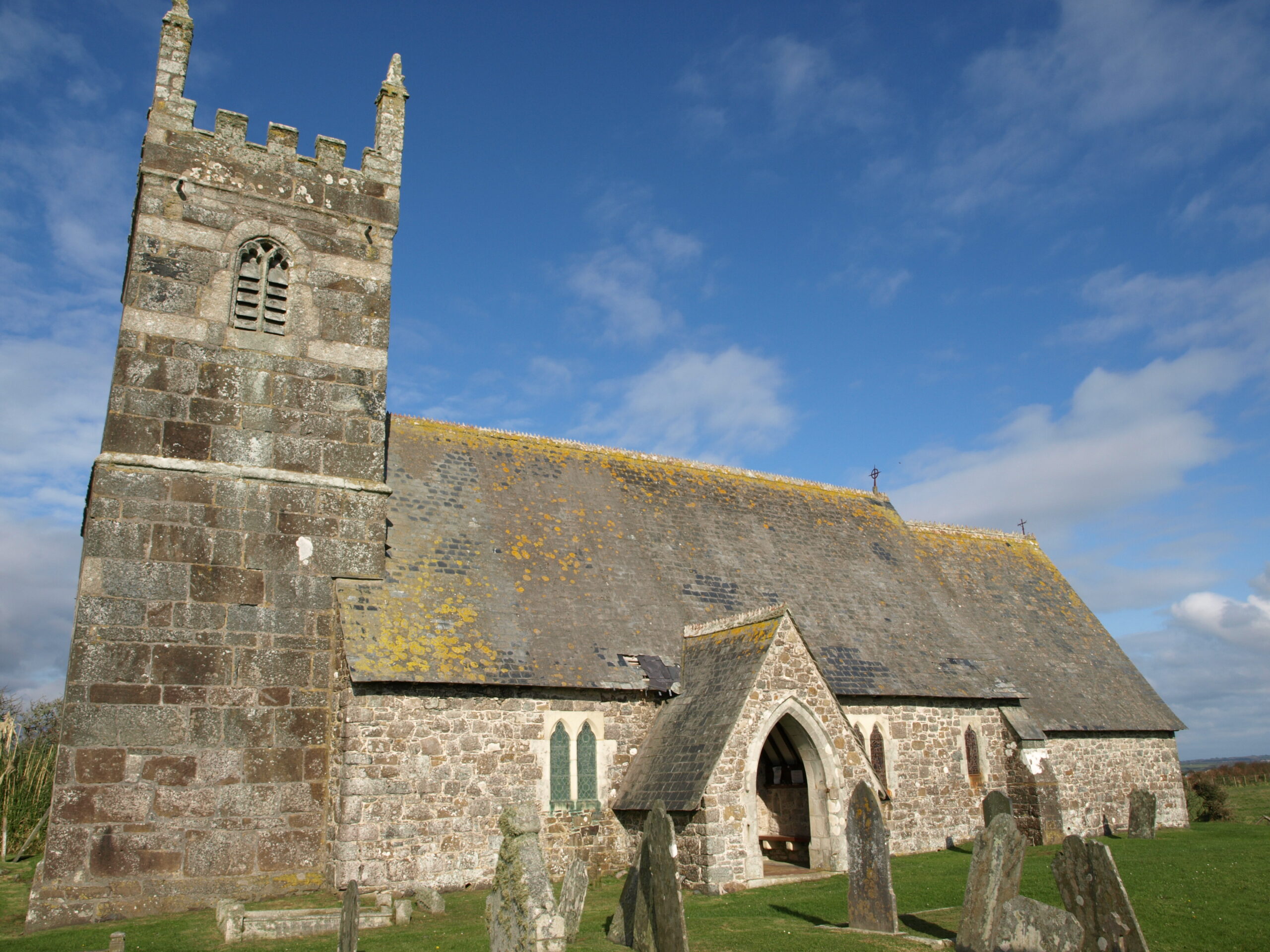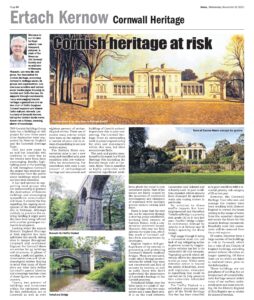Ertach Kernow - Cornish heritage at risk
Cornish heritage advocates the Cornish Buildings Group have run a buildings at risk project for over three years since September 2020 supported by Historic England and the Cornwall Heritage Trust. This has now come to an end but hopefully will continue in some way as the results have been most encouraging. Besides highlighting some of the buildings at risk throughout Cornwall the project has received new information from the public about buildings which may not have been identified. It has had success in supporting local groups who are endeavouring to prevent the destruction of historic buildings and encouraging sympathetic conservation and reuse. It entered the fray regarding the ongoing development of the Hotel Bristol site in Newquay. Although unlikely to preserve the existing building it might assist the town from being inflicted with another grotesque carbuncle development.
Looking wider the annual Historic England Heritage at Risk register has been published this month, listing sites in danger throughout Cornwall and southwest England. For Cornish heritage sites there are entries for 45 buildings and structures, 21 places of worship, 1 park and garden, 1 conservation area and 176 archaeological entries. Bearing in mind that many of these sites are what help define Cornwall’s special identity and encourage tourism some of these figures are cause for concern. Twenty two percent of buildings and structures within the catchment area for this publication are in Cornwall as well as over eighteen percent of archaeological entries. There are of course many entries which have been on the register for a number of years and its always disappointing to see new entries appear.
The Bodmin Moor conservation zone is not a new entry and classified as in poor condition with low vulnerability but deteriorating. For somewhere with such a vast amount of archaeological heritage and monuments and buildings of Cornish national importance this is quite concerning. The Cornwall Heritage Trust do outstanding work in preserving and caring for sites and monuments within this area, but their resources are finite.
At the time of writing they are fund raising to help in the cost of repairing the roof of St Cleer Holy Well, which needs work carried out to ensure preservation.
The sole park and garden mentioned as a Cornish heritage site at risk in the report is the historic house ruin and wider grounds, formerly part of the estate, at Carclew, Mylora. This is also part of a World Heritage Site. This is classified as highly vulnerable with extensive significant problems albeit the trend is now considered stable. Part of the issues are likely caused by the incursion of residential development and clearance of woodland with multiple private owners owning land there. There is hope that the core site can be improved through a steering group established, working with owners of Carclew House, with a conservation statement issued. However, this may not fully address the wider area, which like much of Cornwall suffers from encroachment by developers.
Regular readers will perhaps know of my interest in preserving and protecting Cornwall’s historic medieval bridges. These are constantly under attack through modern vehicles for which they were not constructed and lack of concern by tourists, as well as sadly those who don’t understand the importance of Cornwall’s heritage to the Cornish economy.
Trekelland Bridge over the River Inney is a Grade II* medieval bridge with two main arches and a span flood arch. It is on the road between Launceston and Liskeard and is heavily used. In poor condition, repeated vehicle impacts have damaged its approach walls and coping stones in particular. No solution to these traffic impacts has been implemented and therefore Trekelland Bridge is a priority risk grade (A) as it was last year. Another bridge subject to continuous damage by vehicles is at Helland near St Mabyn spanning the River Camel. High usage through it being a convenient short cut and lack of any mitigating action to prevent access by inappropriate vehicles has led to its vulnerable (B) risk category. Vegetation growth which adversely effects the stonework is also an issue. Whilst some remedial action is beyond the ability of local folk, scrub and vegetation clearance is something that could be carried out to help preserve this vulnerable scheduled monument.
An important part of Cornish heritage from Cornwall's industrial history is the Treffry Viaduct which is a scheduled monument and part of the World Heritage Site. This has been classified as in poor condition with a remedial priority risk category of (B) as last year. However, the Cornwall Heritage Trust who own and manage the viaduct have been working with Historic England to correct the issues relating to the escape of water from the aqueduct channel and secure the future for this valuable heritage monument. Hopefully soon this monument will be removed from the at-risk register.
Of course, churches form a large number of the buildings at risk in Cornwall, which has a total of 305 Church of England buildings, excluding several defunct churches no longer operating. Of these there are 211 which are dated to medieval times, prior to the Reformation. These buildings are not just places of worship, but an integral part of Cornwall’s historic heritage around which many of our earliest settlements grew and came into being. On the Historic England At Risk Register are 21 entries for places of worship. Like other sites and buildings these are risk graded from A (Immediate risk of further deterioration or loss of fabric; no solution agreed) to F (Repair scheme in progress….) Many are in poor condition but vary in degree of risk. Some that have been sold await restoration and conversion within the limitation of their designation as a listed building.
Besides the Church of England there are hundreds of later non-conformist churches and chapels, the numbers of those which are places of worship diminishing every year. This is besides many that have already been sold and converted into residential homes, which of course is far better than falling to the developer’s bulldozers. Cornwall as an early stronghold of Methodism saw many hundreds of chapels built and a history of many of these can be found as part of the Mapping Methodism project. Sadly, many of those still operating as well as those decommissioned are falling into decay and ruin, a great loss to Cornwall’s historic building stock and social heritage.
There is help by way of grants to help fund maintenance and restoration including through the Cornwall Historic Churches Trust. This charity ‘will consider helping any church, chapel or meeting house of any denomination which is open for worship’ towards ‘the preservation and maintenance, improvement, upkeep, beautification and reconstruction of churches in Cornwall’ This includes most but not all aspects of church infrastructure. Churches large to small are included and their current church of the month is St Nun at Pelynt. In September St Nun received a Small Projects Grant of £1,000 towards repairs to the tower roof. Small early repairs can prevent larger work later on. Like most of Cornish heritage listed sites and buildings, which many churches are, public support is needed including people with non-religious backgrounds.
To find out more about the Cornwall Historic Churches Trust or donate to support them click the banner below
St Grada & Holy Cross Church at Grade-Ruan is a Grade I listed building in a poor condition, risk grade (A). This somewhat isolated medieval church dates from the 14th century and desperately needs work carried out to repair the roof and tower. The weather on the Lizard peninsula is challenging for historic buildings and to this end a Friends of St Ruan and St Grade Historic Church Buildings have been set up to raise funds. They have an ultimate target of £300,000 with £140,000 specifically for St Grada’s roof. So far nearly £80,000 has been raised.
Other churches with a high at-risk grading include St Martins Church at Lewannick (A) and in poor condition. The roof leaks and serious issues with the tower. This Grade II* listed building seems at present to have no support group to raise funds, one can only hope that there is one. Most of the other churches on the Historic England risk register fall into category (C) ‘slow decay; no solution agreed’. With building costs rising delays in carrying out necessary works will gradually lead to these rapidly deteriorating further, a most worrying prospect for Cornwall’s historic church heritage. All over Cornwall ‘Friends’ groups are helping preserve their local parish churches, so when visiting please pop something in their fundraising boxes.
The Old Rectory at St Columb Major built in 1851 by William White is considered a Gothic Revival masterpiece and a listed Grade II* building. It is in very bad condition and in the highest at-risk grade (A). Some vegetation clearance work has been carried out, but it seems that the owner has little interest in carrying out maintenance. Listed by The Victorian Society in 2011 as one Britain's most endangered buildings, society director Dr Ian Dungavell stated. 'The owner must be persuaded to properly secure the building or sell up. Future generations won't forgive us for leaving our heritage to deteriorate beyond repair.' It seems that since then the owner has shown little interest in carrying out maintenance and Cornwall Council has failed to serve an Urgent Works Notice on the owner to make repairs.
Unfortunately, space only allows an overview and something of the archaeological entries and non-ecclesiastical buildings at risk will have to wait for a future week. Those folk wanting to engage in helping preserve Cornish historic heritage through clearance work could contact an existing organisation or consider setting up your own group. There is plenty of advice available from Cornwall Archaeological Society or Historic England.














![[178] Ertach Kernow Heritage Column - 22nd November 2023 - Cornwall Museum Partnership, Cornish Heritage in Penzance Ertach Kernow Heritage Column - 22nd November 2023 - Cornwall Museum Partnership, Cornish Heritage in Penzance](https://www.cornwallheritage.com/wp-content/uploads/2023/11/178-Ertach-Kernow-Heritage-Column-22nd-November-2023-Cornwall-Museum-Partnership-Cornish-Heritage-in-Penzance.jpg)